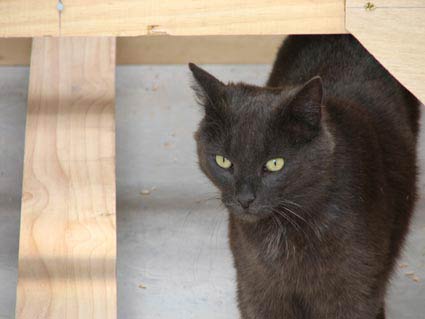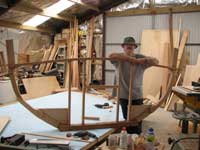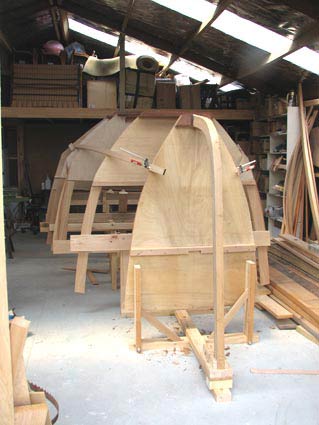|
Sundowner Update |

|
|
By Charles Whipple - Hamilton, New Zealand |
I’ve been framed
The continuing saga of building Resolution - Update 1
(Original Story)
Last year I committed to building Resolution. Not to learning how to make up my mind, but to constructing a Sundowner cutter from the board of small boat designer John Welsford of Hamilton, NZ. As if that commitment were not enough, me having five thumbs on each hand, I also decided to do the job in New Zealand, half a world away from my home in Chiba, Japan.
Well, my thumbs and I picked ourselves up and put ourselves on an Air New Zealand flight to Auckland (pronounced Oakland) where no one waited at the airport and I had no car. A telephone call and two hours later John arrived and we were off to Hamilton. The days went by in a whirl. I bought a small trailer house (called caravans in NZ) for NZ$2700 and an ancient Mitsubishi station wagon for $1100. I rented a parking spot for the car and caravan at the Waikato Outdoor Society (which is five minutes drive from the workshop) and set up house. So within two days, I was ready to start building. . . but John had drawn only the sail plan and the accommodation/deck layout he’d sent me for initial commitment.

Cloudy, the workshop cat
“Come on,” John says. We hook a little two-wheeled trailer to his car and whip 16 km down the road to Cambridge where John knows a guy who laminates beams for the construction industry. “Came to raid your castoff shed.” John grins. Shane the manager grins back. He knows John’s raids mean after-work beers for the crew. Behind the workshop, we find a half-dozen rejected laminated beams 50 mm thick and about 200 mm wide. We lash them to the trailer, and within a day they have metamorphed into the jig that will support my Resolution as my thumbs and I work to build her, and the worktable upon which her components will come to life.
For a month, I laminate ten deck beams and a 15-ply stem of 6mm Fijian Kauri strips. When I’m not laminating, I’m measuring and cutting components for main and fore hatches. That includes a lamination job, too. Two hatch covers made of three plies of 3mm plywood. As John says, you could dance a jig on those hatch covers and they’d never give in.
In building the hatches, I come in contact for the first time with tiger wood. John says, “Tiger wood is Hopea Gabrifolia from and area that covers Timor, Indonesia,
Malaysia and the Philippines. It’s dark brown with vertical striping and
weighs in at about 820 kg per cubic meter. Slippery, wear resistant, and
not easily split.” Slippery? Tiger wood’s the slickest stuff this side of wet soap. Coming back from the lumberyard with four slabs of tiger wood tied in with some Fijian Kauri, the darned tigerwood kept slipping through our best rope work. Both John and I have been around boats and marlinspike knottery for decades, but neither of us could make that wood stay put. We did manage to get it to the workshop in Matangi without losing any. But two planks got their corners ground off on some of New Zealand’s pea-gravel-and-asphalt paving.
John took off on a trip to the States. I stay behind to laminate and make hatches. When he gets back, the lamination’s finished but the hatches are just piles of pieces. He looks at the deck beams leaning against the wall and says, “Not bad for a guy who’s all thumbs. I guess the old saying must be true. An expert is just a beginner with a little experience.”
The next day he does another sheet of the plans. Bulkhead No.5.
My Resolution/Sundowner has ten bulkheads plus a transom. No.5 is located right aft of the galley to the port and the navigation station to the starboard. Its outside edges form the frame for chines and stringers and gunnels that will create the shape of my boat.
I repaint my light blue worktable to eliminate the beam offsets and curves, and start laying out the frame. Four days later, a bulkhead of 12mm plywood and 20mm kauri doublers for the framework stands against the wall. I’m well and duly framed.
While my thumbs and I build No.5, John produces the drawings for bulkhead Nos 4, 3, 2, 1, and 6. I make them as fast as I can, but somehow he’s always a step and a half in front of me.
 This is the No.7 bulkhead and the thumb-ridden builder.
This is the No.7 bulkhead and the thumb-ridden builder.
(click image for larger view) |
November 1 is my birthday. I celebrate it by laying out bulkhead No.7 on the painted blue worktable. November 2 sees me bandsawing the frame and its fore and aft doublers from 20mm kauri. No.7 is the bulkhead that comes at the aft of the cabin. That means it has an opening port and starboard for the quarter berths. Those openings are sided by the frame and its doublers so they’re 60mm wide and bandsawed into a pleasing curve that will not crack ribs when the weather acts up. In the afternoon, I heft a big log of kwila hardwood, which feels slightly heavier than steel, and planed it down to 70 x 80 mm – is used a power plane. A month would not be enough time to hand plane down a floor log of kwila. It’s that hard. Once the floor log’s down to size, I countersink and drill two 12mm holes for keel bolts, and chisel out four notches for the uprights that form the edges of the wet locker, the engine box, and the area for tools and battery.
By November 3, I’ve got No.7 dry-fit and screwed together. I use the final hour of daylight to epoxy the deck beam to the frames and the uprights. On November 4, I glue up the rest of the bulkhead, setting in the plywood webs, the uprights to the hardwood floor log, and cockpit floor crosspiece to the inner uprights. This frame and bulkhead smelled of seaweed and saltwater, to me anyway. With No.7, I saw my Resolution begin to come together.
John hands me a new sheet. “Here’s No.8,” he says. “It forms the forward wall of your cockpit well.”
I clear off the worktable and lay out the lines full size. Tomorrow I’ll bandsaw the frames and glue them together. If I’m lucky, I can get the kwila floor log ready to chisel. Three more days to finish No.8. Four for No.9, four for No.10, and that many again for the transom frame.

Two weeks from now and I’ll be completely framed. Then the setup begins in earnest.
# # #
Charles T. Whipple
|